Dictionaries define indoctrination as:
- the act of indoctrinating, or teaching or inculcating a doctrine, principle, or ideology, especially one with a specific point of view (dictionary.com)
- the process of repeating an idea or belief to someone until they accept it without criticism or question (Cambridge)
- to imbue with a usually partisan or sectarian opinion, point of view, or principle (Meriam Webster)
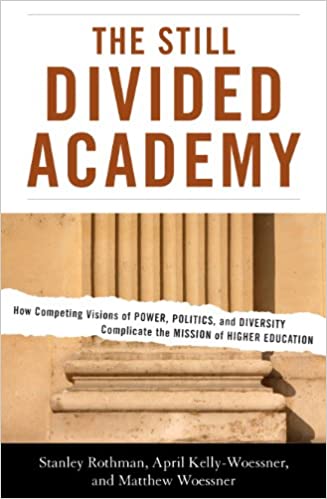
OK, so it’s somewhere between a synonym for teach with some suggestion of a one-sided approach. Universities are bastions of left-wing beliefs, with almost all professors being left-wing and, indeed, it can be difficult in some fields to even find anyone who votes for Republicans. Still, one might wonder if they somehow avoided having their own beliefs affect their teaching, at least, not in an extreme way. Everybody can think of some nice teacher they had at some point, who was opinionated but nevertheless fair and brought up pluralistic debates in the classroom. Probably everybody can also think of some opinionated teachers who failed this duty, and taught their own views in an authoritarian or one-sided manner. So where on this scale is the average professor? Furthermore, does it work? Humans are not that stupid, after all, that they cannot recognize that teaching is overly biased in some direction. They then kinda shrug it off. Maybe. Arm chair speculation cannot settle the question of whether university education per se makes people more left-wing or more woke. What does the data say? There are some ways to study this idea. OK, we probably won’t randomize some people to receiving education and others not so (well maybe), but one could look at regression discontinuity situations, or maybe some natural experiments. I am not aware of these, but maybe they exist. There are however some simpler cross-sectional data, and some longitudinal datasets which provide some insight. A while ago I read a book that examines one such large survey: The still divided academy (2011) by Stanley Rothman et al.
You may remember Stanley Rothman, because he was also the guy who did the study of intelligence researchers in 1984, with a book length version in 1988: The IQ Controversy, the Media and Public Policy, together with Mark Snyderman. He also has some other juicy stuff such as Roots of radicalism : Jews, Christians and the left. Sadly Rothman died back in 2011, so we won’t see more works from him. I would guess he was Jewish based on the name, so he can serve as a nice counterexample of those with overly crude anti-Semitic views about intelligence research and communism in general. Anyway, their book is an analysis of a large survey given in the 1990s, but which the authors didn’t analyze properly until much later. So it was already out of date when the book was published, but nevertheless paint an interesting picture of how students, professors, and administrators taught back then. AS they explain:
The North American Academic Study Survey (NAASS) was conducted by The Angus Reid Group in 1999 and included surveys of professors, administra- tors, and students. In part, the study was a follow-up to Ladd and Lipset’s earlier work in The Divided Academy and Rothman’s earlier work in American Elites. Rothman, Lipset, and Nevitte published some findings from the survey in 2002 and 2003 with articles in The Public Interest, the International Journal of Public Opinion Research, and Academic Questions. These articles explored the impact of racial diversity on college and university campuses. Following the deaths of Ladd and Lipset, Rothman invited his former coauthor, S. Robert Lichter, president of the Center for Media and Public Affairs, to join the research project. Together, Rothman, Lichter, and Nevitte published an article in The Forum in 2005 that investigated the relationship between political views and professional advancement among college faculty. Rothman and Lichter continued this line of research with a book chapter in The Politically Correct University: Problems, Scopes, and Reforms (Maranto, Redding, and Hess 2009).
While Rothman was successful in publishing some significant findings from the survey, the deaths of Ladd and Lipset, along with Rothman’s own illness, delayed further work on the project. Both Nevitte and Lichter, while instrumental in the earlier articles, were constrained by long-standing profes- sional responsibilities that prevented them from devoting the time required to complete the project. As such, important findings from the NAASS remained unpublished. Renewed efforts to write a book based on the NAASS findings began in earnest in November 2007 when, at an American Enterprise Institute research conference, Professor Robert Maranto introduced Stanley Rothman and Robert Lichter to April Kelly-Woessner and Matthew Woessner. Like Rothman and Lichter, the Woessners had been charged with writing a chapter for Maranto’s edited volume, The Politically Correct University. Noting their prior work on politics in academia, Stanley Rothman invited the Woessners to join the project. By January 2008, the newly constituted research team of Rothman, Kelly-Woessner, and Woessner began work on a comprehensive examination of the NAASS data set.
The complete table of contents are here for those considering whether to read it:
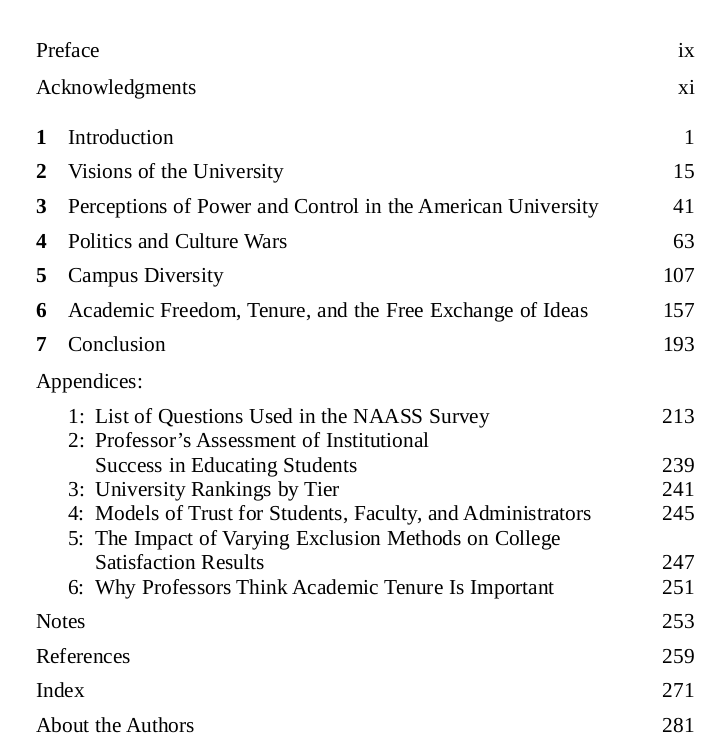
To return to our main topic: does university instruction make students left-wing? Are they getting indoctrinated? First simple test: if university instruction makes students more left-wing, we would expect that students who go thru a 4 year program (Bachelor degree in US) would become increasingly left-wing over their studies. Ideally, one would follow the same students over time to look for this, but if not, one can use a cross-sectional design. This design would then assume the composition of students hasn’t changed too much to bias the results. Composition of the student body can change over 4 years due to selective drop-out, and changes in incoming students, but probably not that much.

Since the sample size is large, you can simply glance along the right column for any stars, anything with ** is worth taking seriously, something with * is a maybe (the p value is between .01 and .05). So of the good hits, there are only 2: students become less likely to agree that the government should work to reduce income gaps, and less likely to think the government should work to ensure everybody has a job. So it seems like the universities make people more conservative! There is one maybe hit for acceptability of homosexuality. Looking at the data, the effect is basically just that the 1st year students are much lower than 2-4th year students. So maybe that means something, maybe not. Overall, however, there is not much to see. Length of stay in university seems mainly unrelated to people’s various political beliefs including party identification.
OK, but maybe things are different now a days? Maybe universities were kinda OK in 1999, but have now become worse (or better, depending on your view). Jeffrey Sachs reviewed some of the newer evidence in 2020, and finds much the same pattern as above: No, Professors Are Not Brainwashing Their Students. According to him, “one of the most rigorous studies of its kind” is that by Colin Campbell, Jonathan Horowitz from 2015 (Does College Influence Sociopolitical Attitudes?):
Past research shows a statistically significant relationship between college completion and sociopolitical attitudes. However, recent scholarship suggests the effects of college on social outcomes may be confounded with unobserved family background. In this study, we leverage the shared family and social background of siblings to better identify the effect of college on sociopolitical attitudes. We draw data from the Study of American Families and General Social Survey and use sibling fixed effects to assess the effect of college on political orientation, support for civil liberties, and beliefs about gender egalitarianism. We find that earning a four-year college degree has a significant impact on support for civil liberties and beliefs about gender egalitarianism, but the effect of college on political orientation is confounded by family background.
OK, so just guessing from the abstract, college does seem to do something maybe. Here we looking at a sibling control design, so since siblings vary in their genetics, a finding of college attendance is associated with something doesn’t prove one caused the other. It could be that the residual genetic variation causes both. But let’s look anyway. First thing to note is that their data is quite old, actually older than the survey in the Rothman book! It’s from:
We draw data from the 1994 General Social Survey (GSS; Smith et al. 2011) and the Study of American Families (SAF; Hauser and Mare 1994) to test the relationship between college and sociopolitical attitudes, net of family back- ground. The GSS, conducted by the National Opinion Research Center at the University of Chicago, was administered to a nationally representative sample of non-institutionalized adults and included a variety of items on sociopolitical attitudes and respondent demographics. The SAF is a companion data set to the 1994 GSS, enabling researchers to test for similarities within families. The GSS first collected identifying information for one randomly selected sibling for each of the 2,992 respondents who had at least one sibling above the age of 25. SAF researchers then conducted telephone interviews with 1,155 siblings, asking a subset of the questions in the GSS. By combining SAF and GSS data, we were able to construct a data set that contains data on 2,310 individuals and 1,155 sibling pairs.
…
The combined GSS-SAF sample has one additional limitation: it was conducted in 1994. Close to half of the participants were college graduation age in the 1960s and 1970s, about one fifth of respondents were college graduation age prior to the 1960s, and about one third were college graduation age in the 1980s and early 1990s. As a result, the findings roughly reflect the effect of college education from the end of World War II until the Republican revolution that elected Newt Gingrich as speaker of the House. Since then, college costs have risen, the rate of college attendance has increased, and universities have become more oriented toward research and grant funding (Brennan 2008; Brint 2005; Horowitz 2015; Slaughter 1985; Slaughter and Rhoades 1996). Thus, the effects of college we report here are limited to a particular time frame and may have changed as the college experience itself has changed.
So really, this is a study of the effects of college education in the 1960s and 1970s! Their results in tables are below. I’ve cut off the bottom half as they were too big and uninteresting anyway. We only really care about the betas for the college completion measure in the first row. First, they have a liberal political ideology measure, and a 7-item political ideology scale. Neither finds anything at p < .05, but looking at the standard errors for the latter, this cannot be just accepted as a null. The adjusted cross-sectional beta is 0.18, and their SE for the sibling study is 0.15, so basically it had no power to find a realistic effect size. The same problem is with their regression for liberal ideology.

Civil liberties sounds like one of those misleadingly named scales, but actually it is not. It’s a measure of support for free speech and academic freedom. It’s an index of whether you would allow a [communist, militarist, atheist, racist, etc.] to speak on campus, or support removing their books. Higher scores mean more pro-freedom views. Here we see that the sibling beta is about the same as the adjusted cross-sectional one: 2.5 vs. 2.4. Thus, maybe college was indeed making students more pro-free speech … in the 1960-1970s!

Their gender equality measures are again underpowered, there’s 2 findings with dodgy p values (1 asterisk). The effect sizes are fairly consistent with the cross-sectional results, so we might go: maybe.

Rounding up this study then we find that it’s not very convincing due to low power on the most important analysis (the first), and the use of very old data of questionable relevance to modern universities. The use of sibling data means there is no control for the residual genetic variation within families, so maybe these numbers just reflect that.
The next study cited is that by Mack D. Mariani and Gordon J. Hewitt (Indoctrination U.? Faculty Ideology and Changes in Student Political Orientation, 2008), which does use a large longitudinal sample. Their analyses are kinda odd, but they provide this table:

Comparing the 1st year with the 4th year students, the 4th year ones are somewhat more left-wing. Causal? The results below show that in the ANES sample of the same age (but n = 94!) the same tendency was seen. So maybe younger people just in general moved left in this period. Or maybe they really moved a little left, and the comparison sample from ANES has sampling error in the same direction. We can’t really tell from this, but the effect size can’t be very large in general. The authors also conduct some more regression analyses trying to look at the effects of specific faculty and institutions and student variables:

The only two things to pop op (p < .01) here are that students at non-religious universities moved more left, and women more left than men. So it seems to fit the narrative of universities making atheist women left-wing, as kind of a religion replacement. Or maybe this has nothing to do with college and just reflects young women in general moving left across these 3-4 years (1999 to 2003).
The final study I found is that by Logan Strother et al from 2021 (College roommates have a modest but significant influence on each other’s political ideology). It has a neat method:
Does college change students’ political preferences? While existing research has documented associations between college education and political views, it remains unclear whether these associations reflect a causal relationship. We address this gap in previous research by analyzing a quasi-experiment in which university students are assigned to live together as roommates. While we find little evidence that college students as a whole become more liberal over time, we do find strong evidence of peer effects, in which students’ political views become more in line with the views of their roommates over time. This effect is strongest for conservative students. These findings shed light on the role of higher education in an era of political polarization.
Their follow-up is only 1 year, but they find a slight increase in right wing views across these times (P < 0.05 say the authors):
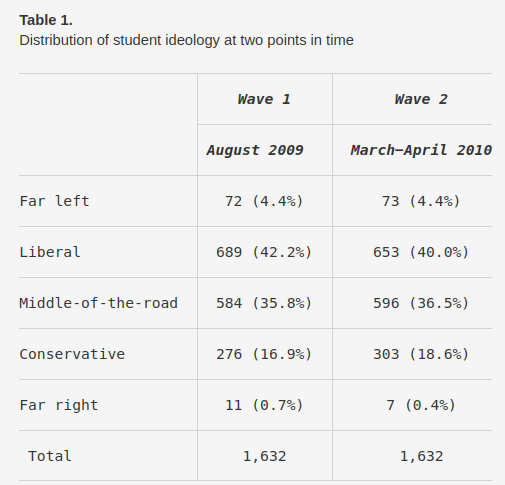
Randomly assigned roommates however, do have some effect of getting people more similar:

Visually:

Large error bars from this analysis, but seems OK overall. Students assigned conservativer roommates get more conservative, those with liberaler roommates more liberal. The effects are quite small however. E.g., looking at the 2 points more conservative roommates, the change in the scale is about -0.3. So in other words, the slope — contagion strength — 15%.
Conclusion
Overall, the various studies are not totally convincing that university education does not cause young people these days to become more left-wing or woke. The sibling study is outdated in the extreme, and has genetic confounding. The other surveys show not much movement across years during studies. This is probably right for a best guess of causal effect size. Merely attending university is not what is making young people so left-wing. I still think universities have a major role in this, but it is not through direct instruction indoctrination. It is through their influence on the wider society via the media. This model is harder to test however.
Extra tables from Rothman survey
These tables were too interesting not to include, but they don’t fit the presentation above, so they are given here.
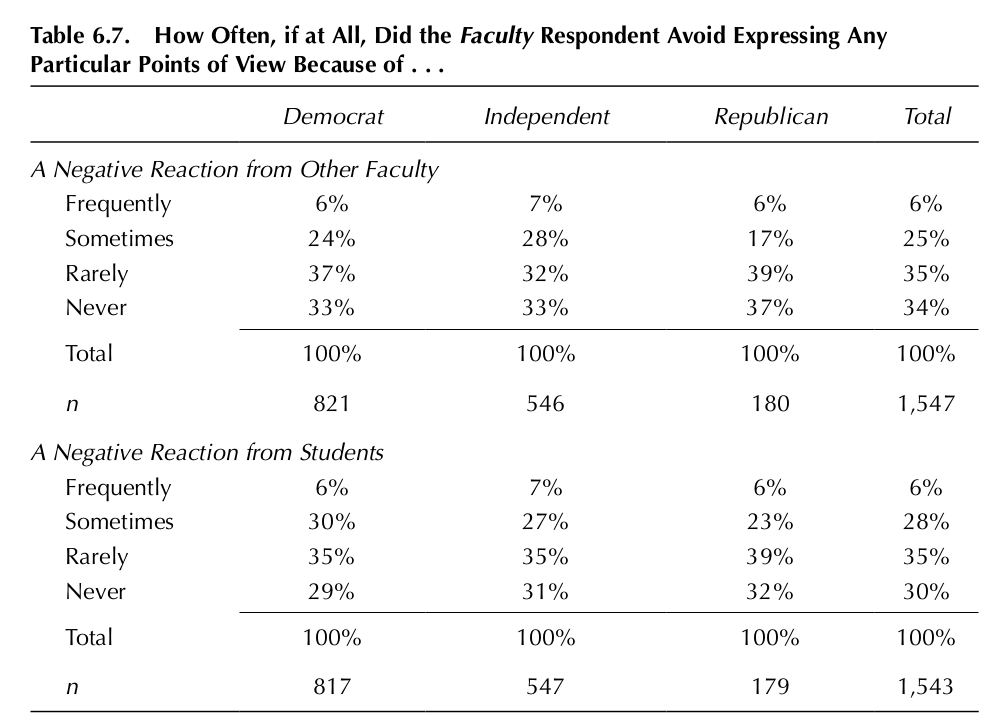
And

These two figures show that self-censorship is not similar now and then. In the CSPI funded Eric Kaufmann study, we know that currently, conservatives self-censor a lot more, but back in 1999, this wasn’t the case among faculty.

So these things have become worse, but the 1990s were surprisingly different!

This figure shows that more elite universities are somewhat more left-wing. This is the same finding as with modern data. One might think this has to do with elite universities having better faculty, but actually not:
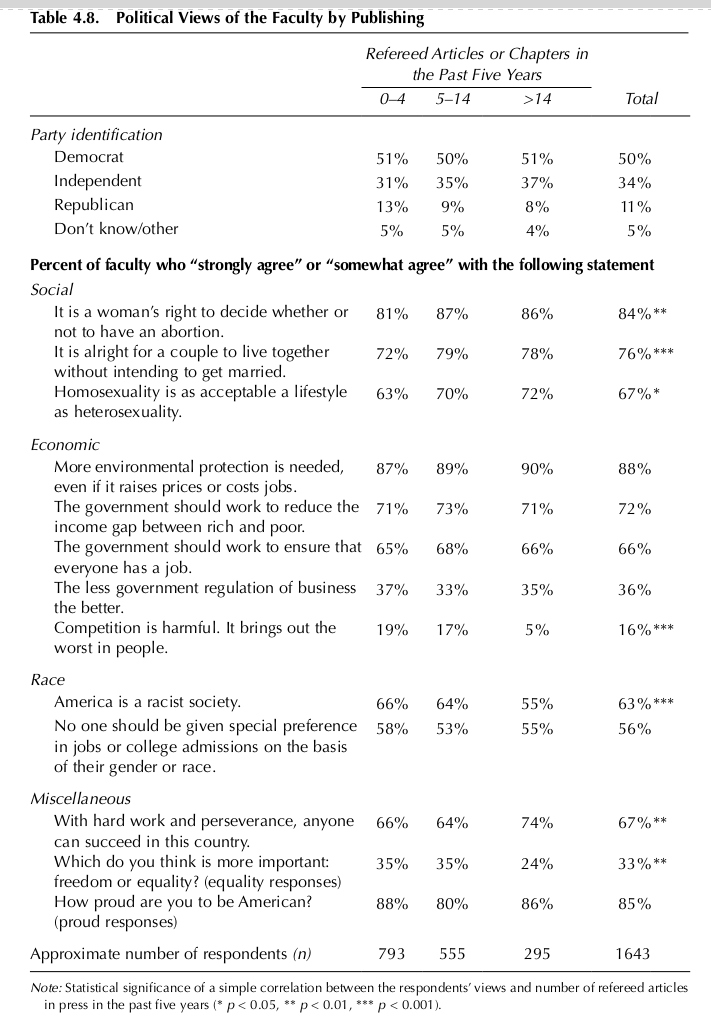
Here we see that more productive faculty are not more left-wing in general, sometimes the reverse. More productive researchers favor more personal freedom (social 3 items), but also more competition (so capitalism), and they buy less into systemic racism, and more into that hard work pays off, and overall that freedom is more important than equality. The difference between the views of those in elite universities therefore cannot be explained by their greater academic merit, but must be something else.

Also replicating (well, pre-replicating) the Kaufmann survey results is that women are decidedly more left-wing in the older data too. Their increase in academia is thus one of the main explanations for the increasing left-wingness of academia, and its other pathologies. Women are as a group bad for academia and science.